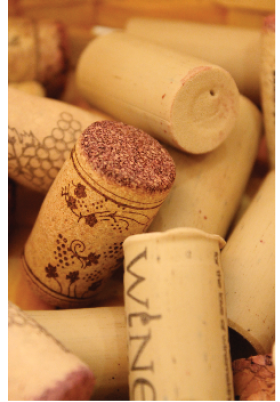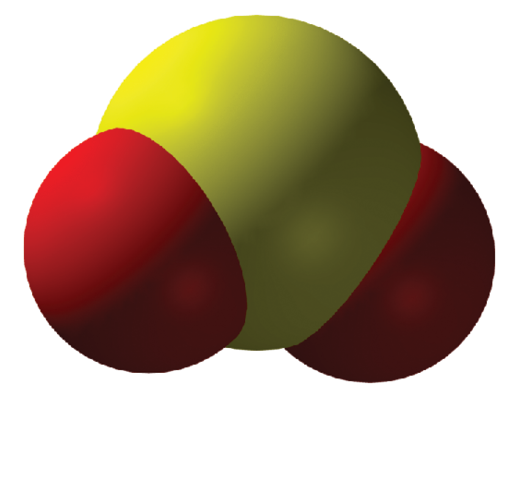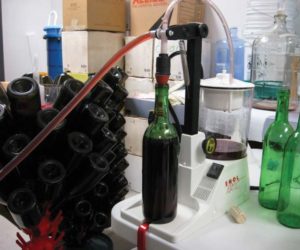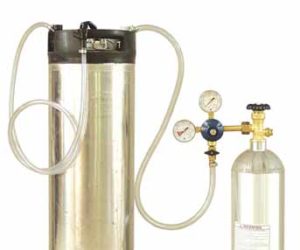Q
The last couple of years I have been sanitizing corks the morning of bottling Frescati Italian Juice. The wine is filtered the day before bottling and corking and there is no sign of mold. Everything is sanitized with a S02 solution and everything seems to be mold-odor free. But then a couple of weeks later we opened a bottle in which the wine had a moldy odor. What am I doing wrong?
John Battistini
Via email
A
Would you be surprised to know that you may be doing absolutely nothing wrong? Even though you tried to sanitize your corks (assuming you are using natural corks and not artificial corks) by soaking in a sulfite solution before bottling, it’s almost impossible to completely eradicate all of the organisms that could cause TCA (trichloroanisole) in a cork. The main reason is because the mold spores might be inside the pores of the cork rather than on the surface where your sanitizing solution reached. There are also many other ways that TCA can crop up later in bottled wines. It should also be noted that there should be no need to sanitize corks from new, unopened bags since these are shipped with SO2.
TCA, or the “corked” off-aroma, is caused by ambient molds interacting with a chlorine molecule of some kind, usually from domestic water supply. When these mold spores metabolize anything containing chlorine they can produce the noxious and easy-to-smell TCA molecules. These mold spores are frequently found in corks but they also can live in drains, on stacked cardboard in the winery, on pallets, or even in the air you’re breathing. Controlling all of the mold spores that might possibly create TCA is quite a daunting task.
I would be curious to know how many bottles were/are affected. If it’s only one bottle, then it’s possible it was the closure, assuming you’re using a natural cork product. If it’s every bottle, then the chlorine-fungus combo that caused the TCA possibly happened because of one of the other scenarios.
This is why most winemakers focus on controlling the level of chlorine in the environment and is why it’s critical to never use chlorine bleach, or any other chlorine-containing cleaning products, in a winery. Make sure that even the towels or rags you use for cleanup are not laundered with chlorine-containing soap. Additionally, always try to use chlorine-free water for winemaking. Commercial wineries have huge filtration set ups but home winemakers can get away with something as small as a chlorine-removing showerhead on the end of the hose. Most hardware and home repair stores stock these. You can also find affordable and slightly larger-scale systems, including manifolds of wall-mounted filter cartridges, with industrial supply companies like Grainger.
Q
Can you explain how to figure Molecular SO2? Here is my situation: I have a 6-gallon (23-L) carboy of Merlot with a pH of 3.6. The free SO2 is at 12 PPM. I’d like to bring the SO2 up to 40 PPM but I can’t figure out how much additional SO2 to add. The online calculator asks for molecular SO2 measurements, which I don’t understand.
Bob Becker
Pleasant Hill, California
A
Sulfur dioxide, or SO2, has many benefits in winemaking and has been added to wine for centuries to act as a preservative. When you add SO2 to your wine, part of it will bind up with other wine components like acetaldehydes, polyphenols, and weakly, to sugars (contributing to “total SO2”) and some will remain free in solution to interact with oxygen, microbial membranes, etc. to help protect your wine. The “free SO2” can exist in three different forms: Bisulfite ion, sulfite ion, and molecular SO2. Additionally, free SO2 swimming around in your wine exists in two forms — molecular and bisulfite. It’s only the molecular SO2 that’s the most
active operator here against microbes and the amount of free SO2 that exists as molecular can change widely based on the pH of your wine. Most experts agree that a molecular SO2 of 0.5 mg/L (or ppm) for red wines and 0.80 mg/L (or ppm) for whites is sufficient for antioxidant and antimicrobial protection. With molecular levels in that range, in my experience, it’s likely you’ll have enough bisulfite in the wine (from the SO2 added) to have decent antioxidant and anti-browning protection as well.
The lower the pH of your wine (the higher the acidity) the more molecular SO2 will be liberated while the higher the pH (the lower the acidity) the more free SO2 will exist in the bisulfite form. This is why it’s so important for winemakers to adjust free SO2 with pH in mind. If you just made adjustments to a specified free SO2 level, your level of protection could differ markedly between, say, a Sauvignon Blanc with a pH of 3.23 and a Cabernet Sauvignon with a pH of 3.78.
If you really want to calculate molecular SO2 by hand, here’s the formula:
Free SO2 = Molecular SO2 x (1 + 10pH-1.8)
If you don’t feel like doing that kind of “new old math” (and frankly, who does), just do what I do and go to the Internet. My favorite places for winemaking calculators include www.winebusiness.com/tools and www.winemakermag.com/guide/sulfite. Go first to the “Molecular SO2” calculator and put in your above parameters. When I did this using the Winebusiness calculator, I got that you needed a free SO2 of 31 mg/L to achieve a protective 0.50 mg/L molecular SO2. Then go back up to the calculator to figure out the addition needed to reach that 31 mg/L free SO2 depending on if you’re adding a liquid SO2 solution or a potassium metabisulfite powder. Since your starting free SO2 is 12 mg/L, you need to add an additional 19 mg/L to get to 31 mg/L free SO2. That’s the “target SO2 addition” that you put in.
When trying to achieve a molecular SO2 goal, keep in mind that high levels of free or molecular sulfur dioxide can be detectable once it gets much above 0.65 mg/L molecular, in my opinion. That’s why it’s great if you can get away with adding less because it’ll affect the bouquet of your wine in a much more limited way. For dry, malolactic-complete reds I try to stick with a molecular SO2 goal of 0.50 mg/L but with some whites, especially those that are malolactic complete, I go for 0.65 mg/L instead. Keep in mind that you’ll want more “active” molecular SO2 in solution if you have a refermentation risk like extra residual sugar, an off-dry wine, or a wine that hasn’t gone through malolactic fermentation. In the latter cases, the 0.80 mg/L level is recommended.
Q
I picked some Sangiovese in tough looking shape. The skins appeared to be oxizided and some of the fruit had some Volatile acidity (VA) going on. I solved the VA problem with some SO2. But the browning of the skins followed it into the wine. pH came in at 3.68 and the Brix was at 25. With my eyes closed, the wine has a nice, light fruitiness typical of Sangiovese. As a tasting experience it’s not too bad . . . certainly quaffable as I like to say. But the optics leave a bit to be desired due to the browning. I’ve read all kinds of articles about browning in whites with PVPP (Polyvinylpolypyrrolidone ), egg whites, etc. but nothing really addresses browning in reds. And this browning obviously came from the skins, not from oxidation of tannins due to aging (it’s 6–7 weeks old). Any suggestions? I’m not averse to stripping it so to speak and then blending in say some Syrah and even making more of a super Tuscan out of it, but how do I remove the browning?
Michael Gardner
Georgetown, Texas
A
There’s the old saw about the sow’s ear and the silk purse. It reminds me of my old adage of “never blend a loser,” which admonishes readers against blending bad wine into good. It improves the bad wine at the detriment to the whole blend. That’s too bad your grapes were sub-optimal and absolutely you did the right thing adding the SO2 to try to combat the rot and potential VA issue.
Unfortunately, rot in both red wines and whites, especially if Botrytis cinerea are present, can mean the presence of laccase, a particularly nasty type of polyphenoloxidase (PPO). PPOs are naturally occurring enzymes in grapes that cause brown pigments in juice and wine. In your case, your rot has probably been unleashed by a Botrytis cinerea infection. Though most winemakers think of white wines when they think “browning,” this is because the colors in red wine often cover up, out-shine, and mask any brown pigments. Red wines, as you’ve found, can experience significant browning due to rot too, especially because the extra skin contact during fermentation compounding time with exposure to the rot on the skins.
In this case, your browning issue was exacerbated by the fact that Sangiovese, especially if grown in a warm area, is what I would call a “lighter color” red like Pinot Noir. It often just doesn’t have the color density and optic power of a darker, denser wine like Petite Sirah or Cabernet Sauvignon. Additionally, extra SO2 can sometimes strip color so what you’ve got going here is a three-part punch: Lower initial color, bleaching by extra SO2 and PPO browning activity. I’m not surprised that you’re not happy with the results.
For future reference, here are some tips for dealing with rot in red grapes:
• Pick as cold as possible to reduce PPO and laccase activity.
• Add at least 50 ppm SO2 upon crushing as the PPO enzyme requires oxygen to work and SO2 is an oxygen-scavenger.
• Try to maintain a carbon dioxide environment in your fermentation vessels before fermentation starts — dry ice pellets do a great job of blanketing a grape bin before the grapes go in, for example.
• Limit cold soaking as this only exacerbates laccase activity.
• Add extra tannin (300 ppm or so of a commercial winemaking tannin) before inoculation to act as oxygen-scavengers and to “beef up” mouthfeel and color stability.
• Do not try a feral fermentation and be sure to use a fast-fermenting “bullet proof” yeast strain like Prise de Mousse.
• Keep maceration short to minimize the time laccase has to operate on your grapes.
• Try to exclude as much oxygen as possible during the aging process.
• Be aware that rot-affected wines may not age as long or as well as non-affected wines.
As for your current batch, I would give fining agents a try. You could certainly try fining out some of the browning with PVPP, and then seeing if you could use the gallons with some darker varietals, as long as you still like the aroma and flavor of the Sangiovese. I say “never blend a loser” but my long-time readers know I also say “do your bench trials.” If you find something that works, and especially something that you like, go for it!







